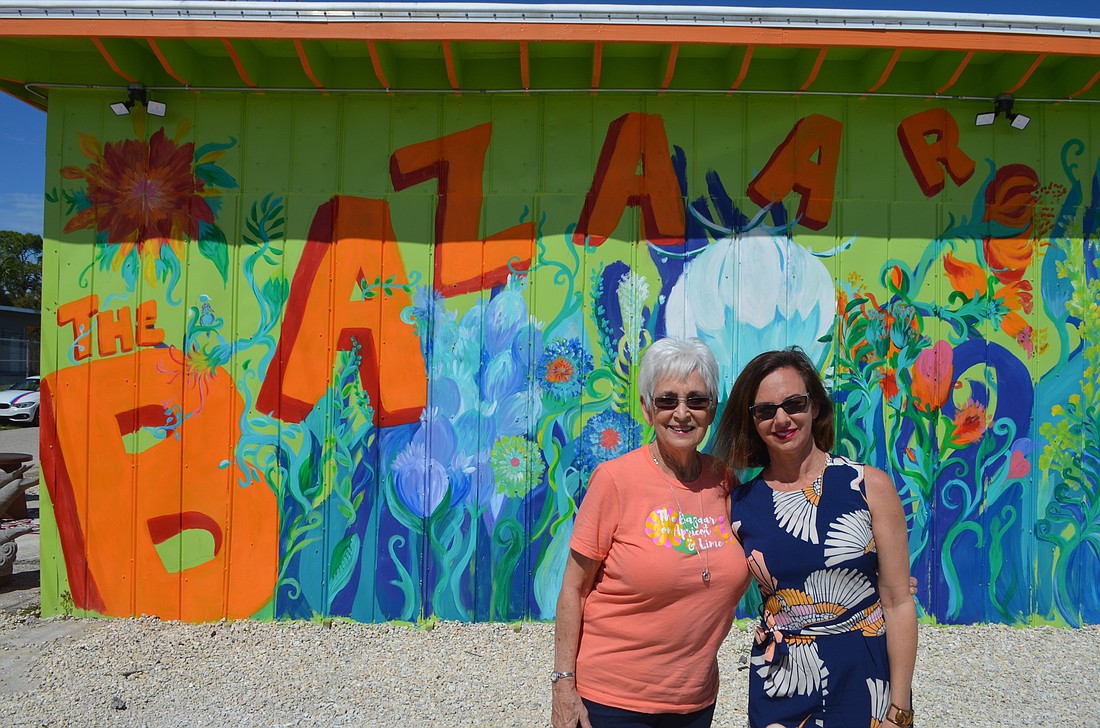- July 26, 2024
-
-
Loading

Loading

As you’re driving past it, The Bazaar on Apricot and Lime can stand out from its surroundings.
Its vibrant orange and green exterior is intentionally eye-catching, part of an effort to lure visitors to a business in an area that isn’t as well-traveled as more centrally located districts, especially on foot.
The indie market has been open for nearly a year, serving as a place where more than a dozen vendors sell artwork and services Thursday through Saturday. It’s owner Judy Alexander’s first foray into running a for-profit business, an operation she oversees with help from her daughter, Kim Livengood.
Although Alexander and Livengood saw some serious potential in the location near Lime Avenue and Eighth Street, it also came with challenges. Livengood, a public relations professional, is intently focused on getting the word out, because a passive promotional approach wouldn’t necessarily draw in a high volume of traffic.
“It’s definitely a struggle,” Livengood said. “A lot of people didn’t even know of Apricot Avenue. I grew up in Sarasota all my life; I didn’t know there was an Apricot Avenue.”
But the Bazaar on Apricot and Lime doesn’t want to just stand out as a hub of activity in an otherwise sleepy segment of the city. A closer look at Lime Avenue reveals other active businesses in buildings with facades that aren’t quite as bright — barber shops, hair salons, bookstores. JDub’s Brewing Co. is within a half-mile walk. Ed Smith Stadium is less than a mile away.
After taking stock of the surroundings, Livengood came up with a strategy for promoting more than just her mom’s business: creating a new business district for the area northeast of downtown. She drew expansive boundaries — 17th Street and Fruitville Road to the north and south, U.S. 301 and Tuttle Avenue to the west and east — and gave the conceptual district a name, the Limelight District.
“There’s downtown, there’s the Rosemary District, there’s Palm Avenue, there’s Gulf Gate,” Livengood said. “We really were just floating in nowhere.”
She’s already begun discussing the concept with a few neighboring merchants, who have shared her enthusiasm for the idea. She’s met with city staff members, who have offered her support in setting up a preliminary meeting with other business owners within the boundaries of the proposed district. The group will have its first meet-and-greet soon, which Livengood hopes is a step toward bigger and better things — and toward a new public perception of the area.
“There’s a lot more retail than you’d realize,” she said.
Livengood isn’t the first person to suggest the city should enliven areas that fall within the boundaries of the proposed Limelight District.
Following renovations to Ed Smith Stadium in the early 2010s, the city heard input from critics who believe new regulations are necessary to encourage redevelopment on surrounding parcels. In 2017, as she was writing a proposal for a new citywide zoning code, planner Karin Murphy was hesitant to make significant changes to the industrially zoned land near the stadium. She feared new regulations emphasizing retail and restaurant could lead to gentrification and the loss of jobs.
Murphy has since departed her position, and the city has since decided not to move forward with large swaths of the proposed code changes. Planning Director Steve Cover was encouraged to hear businesses in the area were organizing, but right now, he said the city doesn’t intend to pursue zoning changes within the proposed Limelight District.
“Until we get some clarity as to what they want to do or direction from the commission, I don’t think we have any plans on doing anything,” Cover said.
That’s not to say the possibility of things changing are out of the question. Although no zoning adjustments are planned, the city is undertaking an analysis of its transportation network, which could identify possible improvements to streets within the proposed district.
And Cover said there are two different scenarios that might bring about changes to land use regulations.
One would be a decline in the activity in the area. If businesses are shuttering and storefronts stay vacant, the city could consider economic and regulatory incentives for redevelopment. That happened in the Rosemary District, where a residential density increase led to a spike in new projects.
Or, Cover said, a coalition of stakeholders within one area could identify an issue and come to the city with a proposed solution. That, too, has happened in the Rosemary District, where residents, businesses and property owners worked together on proposed zoning changes in response to the new development. Cover said the formation of the Limelight District could hypothetically follow the same path.
“Sometimes, communities and districts will approach the city and say, ‘Look, we’d like to do something different here,’” Cover said.
Right now, with the concept in its nascent stages, Livengood isn’t focused on zoning changes. Instead, she wants to create a sense of community, to bring together businesses to improve a section of the city where she sees tremendous potential.
“We have no voice right now, so that’ll help us have a voice,” Livengood said.